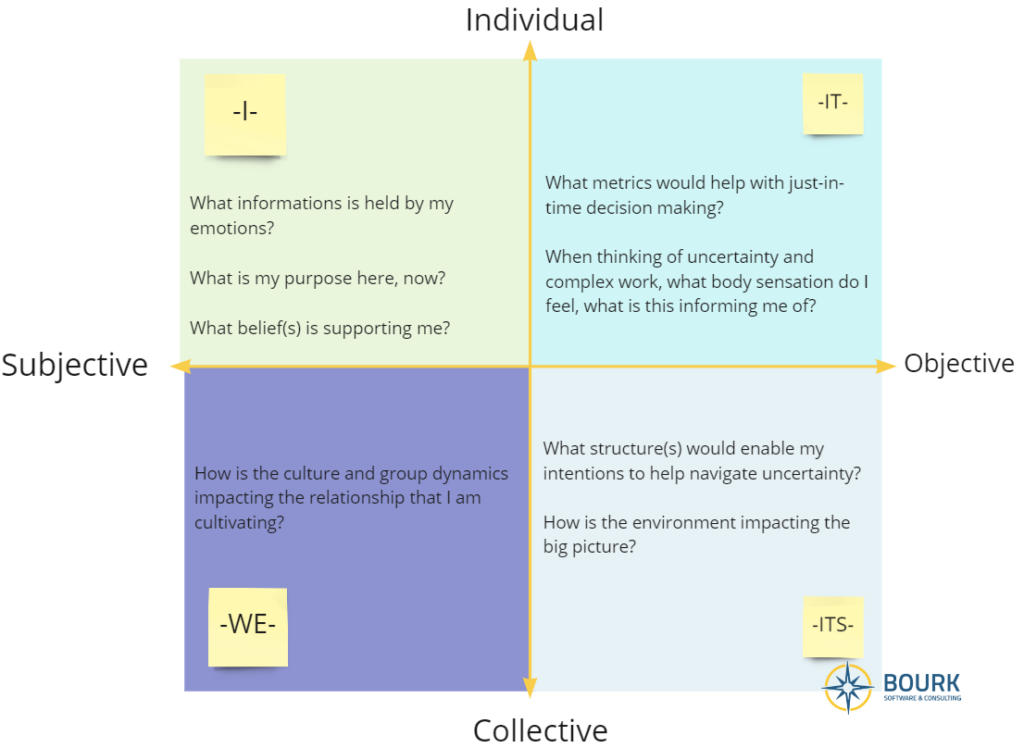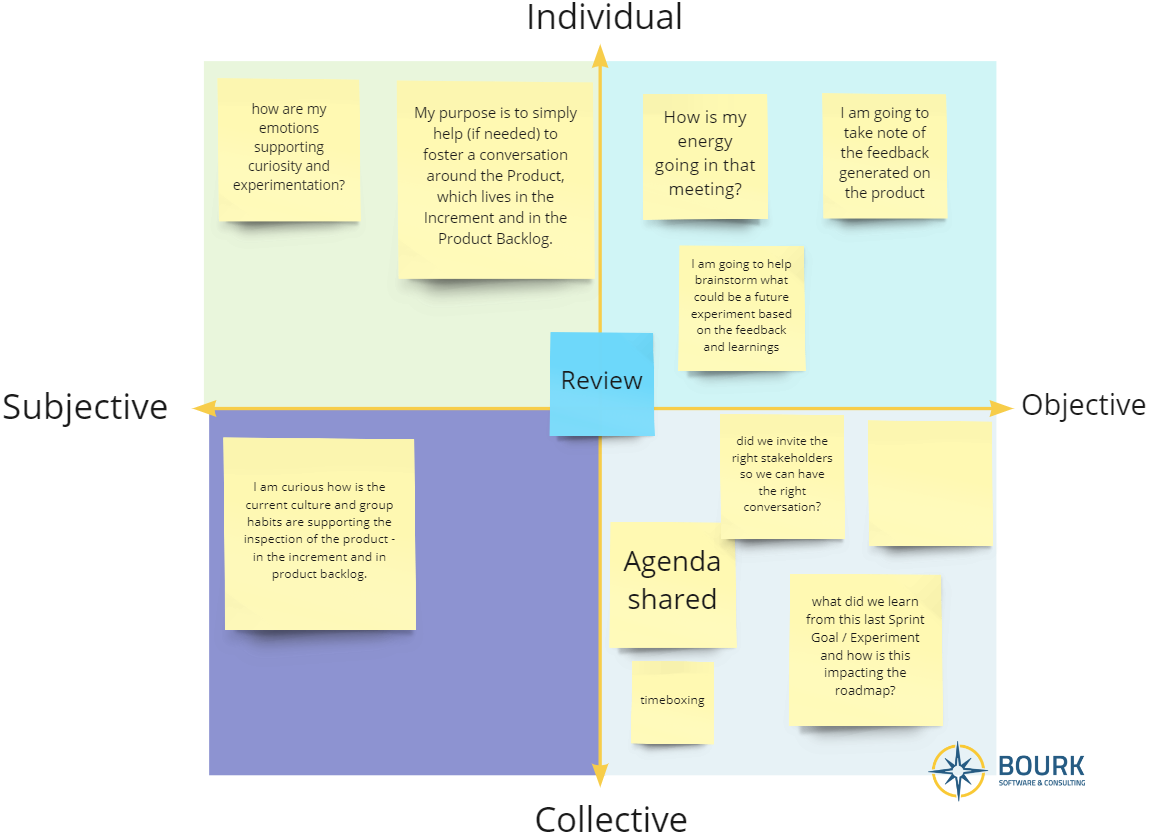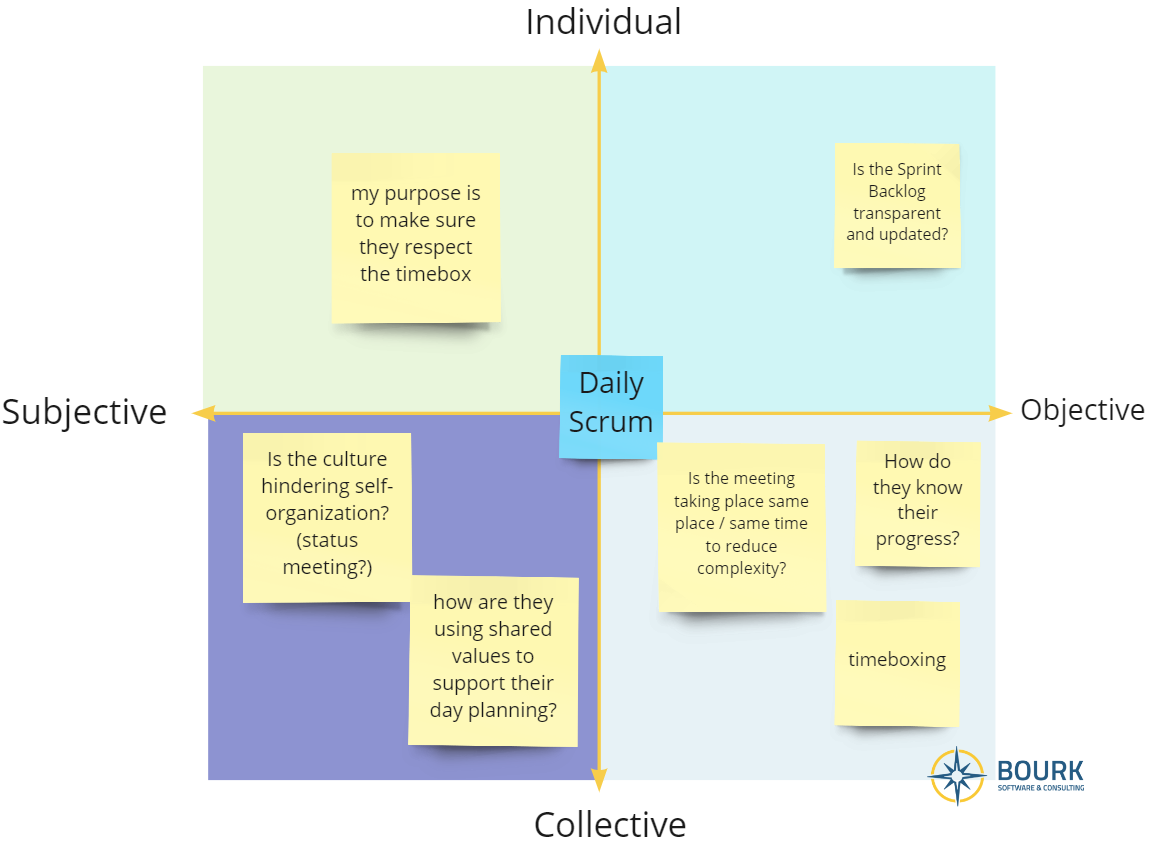Goal
The goal is to help Scrum Masters build self-awareness related to their accountability in the Scrum framework using the quadrants of the Integral Theory.
This is not an activity that aims to a black and white answer, nor that holds the truth around the possible stances of a Scrum Master.
This is an activity that builds self-awareness for Scrum Masters.
Expected Outcome
- At the end of this workshop, the participants will have a better idea of what is expected of them as Scrum Masters.
- Scrum Masters will have increased agility and a broader context for collaborating with many perspectives at once.
- Attendees will leave this workshop with newly created development objectives based on their learning and integrations of new skills and perspectives..
Prerequisites
- It is expected the facilitator has a good understanding of the quadrants from the Integral Theory.
- Ideally, the attendees have some understanding of the Scrum framework beforehand.
How
We will be using the quadrants from the Integral Theory to explore the Scrum’s events, given we are in a complex environment; an environment in which more is unknown than known.
Duration
2h.
Steps
Step 1. Recap the meaning of each Quadrant.
Please refer to a previous post introducing the theory, if you need to have refresher on the meaning of the Quadrants.
The first crux in the explanation of the theory is to clarify the difference between Subjective and Objective (left and right). Subjective is not measurable, it cannot be seeing or touched while Objective is something measurable and more concrete.
The second crux is to clearly set the parameters of the activity. You are looking at the quadrants from your personal perspective – as a Scrum Master! If you are not a Scrum Master, this is a really good opportunity to put your Scrum Master’s skin and pretend! Part of this crux is to avoid the rabbit hole of looking at the entities the Scrum Master serves (the Team, the PO, the organization). You want to look at the Scrum Master, the person.

Step 2. Explore the quadrants in the given context.
- Draw the quadrants for each Scrum Events.
- (5 min) Work the group through an example using the Prompt per quadrant to guide you: write down one sticky per quadrant, for one event.
- (30 min) In groups of 2-3 people, go through all the events, filling each quadrant with stickies.
- (10 min) Recap each event with the participants.
- Fill out what’s missing if needed. (The Scrum Guides is a good companion)
- Answer outstanding questions if any
- Move the items if necessary. Clarify what is Subjective vs Objective.
- Don’t sweat it! The goal is to build self-awareness, not to have absolute truth on each placement!
- Ask the participants to note down the areas they were very comfortable and the ones they were most struggling.
PRO-TIP- If you are experienced using the quadrants, pay attention to the group’s orientation. It’ll be hidden within the way they write their stickies. For example, if they orient from the Upper Right (IT – Objective Individual), their WE (Subjective-Collective) stickies would read like: “observing body language to see if the group is engaged”. If they oriented from ITS (Objective-Collective), you would read something like: “are they speaking using round-robin?” This “orientation” is expected and there is nothing to change out of their answers. This information shines the light on their strengths / weaknesses and can be used to help them decide what to develop next. For now, use it to talk from their orientation as much as you can.
Prompt per Quadrant

Gallery of Examples
Notes
My experiments demonstrated that people new to Scrum are solely focusing on the mechanics of the framework. They will easily fill the Objective side of the quadrants, and the Subjective side will be tinted with Objectivity. If that is the case, spend some time learning about the emotions and the culture.
Step 3. Zooming Out
Next, you want to give the participants some time to reflect on the underlying foundation that support the Scrum Master in supporting the Team, the PO and its organisation. The previous activity holds their perspective, complemented by yours.
Invitation: What are the pattern(s) you see through the different events and quadrants? What seems to be your most and your least favorite quadrant? Why?
Step 4. Development Goals
Using the prompt question from the previous activity: “which quadrant was more comfortable and which ones were you struggling with?” combined with the “zooming out”, invite the attendees to think of a development goal that would be specific to developing one quadrant in a timely fashion, up to one month.
Examples of a development goals:
- (I) I want to be better able to zoom in my emotions so they can inform me something needs to be attended.
- (ITS) I want to be more aware of different structures needed to foster the right conversations among our group.
- (IT) I want to explore what metrics can be used to enable better just-in-time decision-making.
- (WE) I want to explore how to help foster a culture with high psychological safety.
Example from a participant
In this example, the participant made a number of changes after being reminded of the definitions of the words Subjective and Objective, and yet, we can still help students reveal what belief(s) and meaning these words are holding.
I believe there is no bad answers to this activity. It is simply a good way to add clarity to our own understanding. It gives the group a common language and understanding on the different parts of the framework.

Dissecting the example:
Look at the Upper Left (Subjective-Individual) quadrant. Is it not interesting to read to “Be Objective” as a thought? The conversation that followed the activity revealed the desire “not to anchor his own ideas to the group”. To be fully of service. You may ask yourself what this is enabling and hindering.
The sticky “be a Guide” sounds like an action, something that is objective instead of Subjective. It would be insightful to investigate what is the underlying belief that made him write this sticky note, and trying to help the participant to articulate it to write it down.
The stickies in the Individual-Exterior (Lists, Sprint Goal, Sprint Backlog, Whiteboard) should be in the Exterior-Collective space as they are structures that helps the collective to work in the same direction. This would leave this quadrant totally empty – how interesting!
The main idea of reviewing the quadrants with the participants is to help them reveal their blind spots and their strengths, so they can better assess which one of the quadrant needs some attention.
Conclusion
By the end of the workshop, the participants have gained self-awareness on to what their strengths/weaknesses are to best embody their role as Scrum Master.
They also have a development goal to help them develop what they thought would be most impactful for them.
Appreciation
I would like to thank Dave Hill Jr. and Thomas Atterbom who gave me tremendous feedback in the thinking of this article and along with my few updates and edits. 🙏





